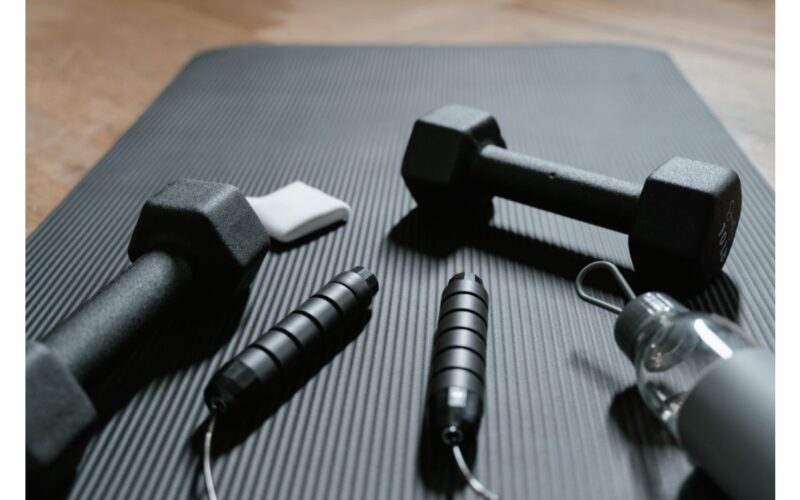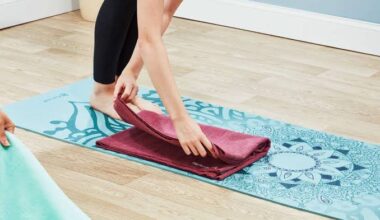Table of Contents Show
Explore our in-depth comparison of Yoga Mat vs Jump Rope Mat, guiding you to make the best choice. Discover the differences, similarities, and unique benefits of each, from material, size, and thickness to durability, grip, and support. Equip yourself with the right mat for your fitness journey!
Have you been searching for the perfect mat for your home workout sessions? With so many different types of mats available, it can be overwhelming to decide which one is right for you. Two of the most popular mats on the market are the jump rope mat and the yoga mat. In this article, we will explore the key differences between the two and help you decide which one is the best fit for your needs.
Disclosure: As an Amazon Associate I earn from qualifying purchases.
Yoga Mat vs Jump Rope Mat: The Basics
Jump rope mats are designed to provide a flat and stable surface for jumping rope. They are typically made of durable materials such as PVC, rubber, or foam and have a non-slip surface to prevent slipping during intense workouts. Jump rope mats are generally thicker and heavier than yoga mats and are designed to withstand the impact of jumping.
On the other hand, yoga mats are designed to provide cushioning and traction for yoga poses. They are typically made of natural materials such as rubber, jute, or cotton and have a textured surface to prevent slipping during yoga sessions. Yoga mats are thinner and lighter than jump rope mats and are designed to provide a comfortable surface for sitting, standing, and lying down.
What is a Yoga Mat?
A yoga mat is a type of mat specifically designed for practicing yoga. It’s usually made from materials like PVC, rubber, cotton, or jute. The thickness can vary, but most yoga mats are between 1/8 and 1/4 inches thick. Yoga mats are often used to provide comfort, support, and grip during yoga poses, helping to enhance the practice and protect the yogi from injuries.
What is a Jump Rope Mat?
On the other hand, a jump rope mat is designed with a focus on providing a durable, impact-absorbing surface suitable for high-intensity jump rope exercises. They’re generally thicker than yoga mats, often made of high-density foam or rubber, to absorb shock, minimize noise, and protect your joints and the floor beneath.
Yoga Mat vs Jump Rope Mat: Which One is More Versatile?
When it comes to versatility, yoga mats have a slight edge over jump rope mats. Yoga mats can be used for a wide variety of exercises, including yoga, pilates, stretching, and bodyweight exercises. They are also easy to roll up and store, making them ideal for small spaces.
Jump rope mats, on the other hand, are specifically designed for jumping rope and are less versatile than yoga mats. While you can certainly use a jump rope mat for other exercises, it may not provide the same level of comfort and stability as a yoga mat.
The Key Differences
Material Differences
Yoga mats and jump rope mats are made from different materials to suit their specific purposes. While yoga mats can be made from a variety of materials, including PVC, rubber, cotton, and jute, jump rope mats typically use high-density foam or rubber to withstand the high impact of jumping.
Thickness and Density
The thickness and density of the mats also differ significantly. Yoga mats usually range from 1/8 to 1/4 inches in thickness, providing enough cushioning for yoga poses while still allowing you to feel a connection with the floor. In contrast, jump rope mats need to be thicker (often 1/2 inch or more) to absorb the impact of jumping, reducing stress on the joints and protecting the floor.
Size and Portability
Most yoga mats have a standard length and width suitable for a variety of yoga poses. They are lightweight and often come with a carrying strap for portability. Jump rope mats, however, can be a bit larger to accommodate the range of movement when jumping rope and may be heavier due to the dense material used.
Durability
Jump rope mats are designed to be extremely durable to withstand the consistent impact of jumping rope. The material used is wear-resistant and less likely to tear or fray. On the other hand, yoga mats may wear out quicker with high-intensity usage but serve excellently for lower impact, steady yoga practices.
Yoga Mat vs Jump Rope Mat: Which One Provides Better Cushioning?
If you are looking for a mat with excellent cushioning, a yoga mat is the way to go. Yoga mats are designed to provide a comfortable surface for your joints during yoga poses and can help reduce the risk of injury.
Jump rope mats, while durable, do not provide as much cushioning as yoga mats. This can be an issue if you have joint pain or are recovering from an injury. However, if you are looking for a mat that provides a stable surface for jumping, a jump rope mat may be a better option.
Yoga Mat vs Jump Rope Mat: Which One is More Durable?
Both jump rope mats and yoga mats are designed to withstand regular use and can last for several years with proper care. However, jump rope mats are generally more durable than yoga mats due to their thicker and heavier construction.
Jump rope mats are designed to withstand the impact of jumping, which means they are made of tough and durable materials that can stand up to regular use. Yoga mats, while sturdy, may wear out more quickly if used for high-impact activities such as jumping.
Yoga Mat vs Jump Rope Mat: Which One is More Portable?
If portability is a top priority for you, a yoga mat is the way to go. Yoga mats are lightweight and easy to roll up, making them perfect for travel or taking to the gym. They can also be easily stored in a small space such as a closet or under a bed.
Jump rope mats, while not as portable as yoga mats, can still be taken on the go. Many jump rope mats are designed to be foldable or have carrying handles for easy transport. However, due to their thicker and heavier construction, they may be more difficult to store and transport than yoga mats.
Top Recommended Yoga Mats and Jump Rope Mats
Top Yoga Mats
- Manduka PRO Yoga Mat: This mat is widely recognized for its durable, high-density cushioning and joint protection. It offers excellent grip, even in sweaty conditions, and is made from PVC that’s certified safe and sustainable. It’s a bit heavier than most mats, making it less portable but more grounded and sturdy.
- Liforme Yoga Mat: This mat is known for its unique alignment system, which helps guide your poses. The mat offers excellent grip, is PVC-free, and biodegradable, making it an eco-friendly option. However, it is slightly more expensive than average yoga mats.
- Gaiam Essentials Thick Yoga Mat: A fantastic option for beginners, this mat is thicker than average, providing extra cushioning for sensitive joints. It comes with a carrying strap for easy transport. The mat is made from non-toxic materials but may not be as durable as some other options.
Top Jump Rope Mats
- EliteSRS Fitness Jump Rope Mat: Designed specifically for jump rope exercises, this mat provides a smooth, fast surface for consistent bounce. Its high-density material protects floors, absorbs impact, and reduces noise. The circular shape offers plenty of room for lateral movements, and it’s portable for outdoor or indoor use.
- Gxmmat Large Exercise Mat: This is a large, ultra-durable mat suitable for various high-intensity exercises, including jump rope. It’s made from high-density foam and features a non-slip surface. Despite its size, it’s easy to roll up and store.
- RevTime Dual-Sided Sports Mat: This mat stands out for its dual-sided use. One side features a fabric-like texture perfect for jump rope workouts, while the other side is smooth, suitable for yoga or other exercises. It’s thick enough to protect your floors and absorb impact but might be a bit heavy to move around.
The choice between a yoga mat and a jump rope mat should be determined by your specific needs, exercise routine, and the available space. By comparing the features, benefits, and potential drawbacks of these top-rated options, you can invest in the right mat for your fitness journey.
You may also like
- Unmasking the Myth of the Yoga Mat as Sleeping Pad: The Truth Unrolled with 4 Factors
- Yoga Mat vs Sleeping Pad: Which One Should You Use for Yoga Practice?
- Jumping Rope on Yoga Mat: A Comprehensive Guide for Fitness Enthusiasts (with 5 Special Yoga Poses to try)
Final Thoughts
choosing the right type of exercise mat is essential to ensure a safe and comfortable workout experience. While yoga mats are suitable for yoga and other low-impact exercises, jump rope mats are better suited for high-impact activities. When making a choice, consider factors such as thickness, material, and durability. Ultimately, the best mat for you will depend on your exercise preferences and needs. Whether you prefer yoga or jump rope, make sure to invest in a high-quality mat that will provide the right amount of support and cushioning for your workout routine.
You may also like our article on yoga mats vs exercise mats.
FAQs
Q1: Can I use a yoga mat for jump rope exercises?
A: While you can technically use a yoga mat for jump rope exercises, it’s not recommended due to the potential damage from the high impact of jumping. Yoga mats are not designed to withstand this kind of repetitive impact and could wear out quickly or even cause injuries due to insufficient shock absorption. A jump rope mat is specifically designed to withstand the force and protect your joints and the floor.
Q2: Are jump rope mats necessary?
A: If you’re regularly doing high-impact exercises like jumping rope, a jump rope mat can be a good investment. It protects your joints by absorbing the shock from jumping and also protects your floor from damage. If you’re jumping rope on a soft or uneven surface like grass or carpet, a jump rope mat can also provide a consistent, level surface.
Q3: Are thicker yoga mats better?
A: The “best” thickness for a yoga mat depends on your personal preference and the type of yoga you practice. Thicker mats (around 1/4 inch) provide more cushioning, which can be beneficial for sensitive joints or poses that put pressure on your knees or elbows. However, they can also make balancing poses more challenging. Thinner mats (around 1/8 inch) allow better stability but offer less cushioning.
Q4: What should I consider when buying a jump rope mat?
A: When buying a jump rope mat, consider its thickness and density for shock absorption, its size (large enough for your range of movement), and the material used for durability. It should be made from a high-density material like rubber or foam to withstand the high impact of jumping.
Q5: Can I use a jump rope mat for other exercises too?
A: Yes, a jump rope mat can be used for other exercises too. Its high-density cushioning makes it suitable for high-impact workouts, while its size often provides enough space for a range of exercises. However, it might not be ideal for exercises requiring a lot of floor contact, like yoga or Pilates, as these might need a thinner mat for better stability.





